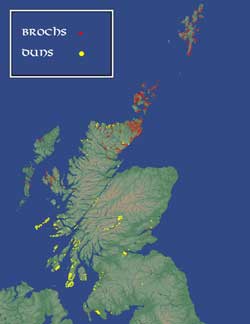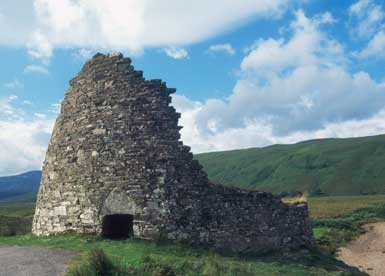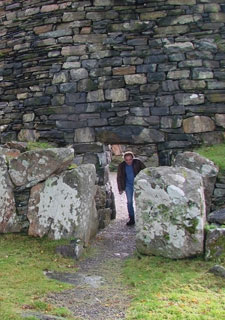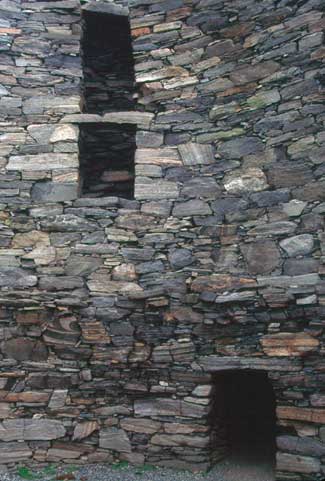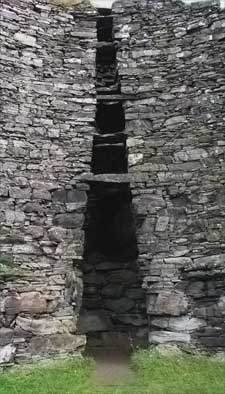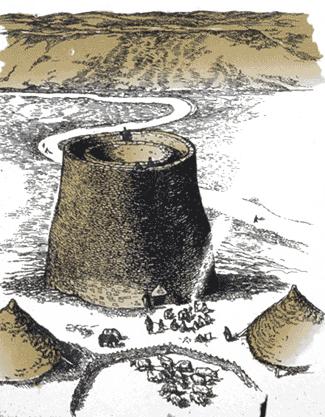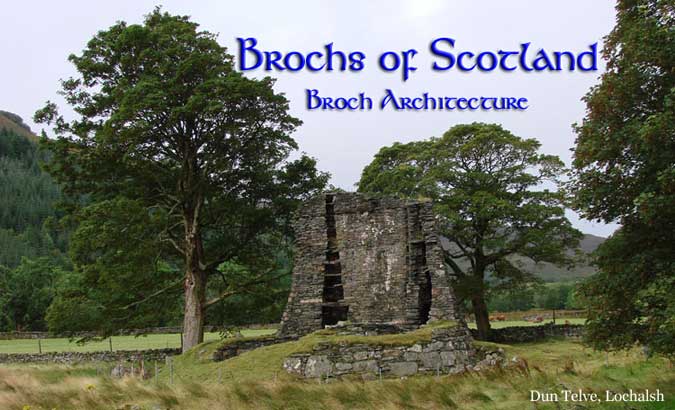
Broch Towers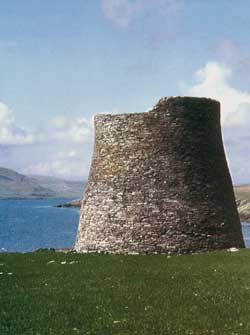
When most people think of brochs they imagine a tall, circular tower but these are by far the exception rather than the rule. In fact, most of them are more elliptical than circular and the general plan is generally adapted to take into account the abnormalities of the building site. Diameters vary widely, ranging from a about 12-24 metres overall (7-17 metres internally). The question of height has been the source of a considerable amount of debate in the past fifty years or so. Many archaeologists believe that brochs such as Mousa (right) in Shetland or Dun Carloway on Lewis were always exceptional and that most roundhouses identified as brochs were not much taller than they appear today.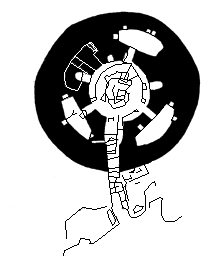
In Shetland, Noel Fojut examined the best-preserved examples and discovered that Mousa was not only by far the tallest (surviving to a height of about 13 metres) but was also the most massive. The walls are disproportionately thick when compared to the amount of internal space available (see plan, left). This was necessary in order to support the weight of the superstructure, especially when the walls were dry stone (i.e. built without mortar or cement). The broch at Mousa is over 15 metres in diameter altogether but almost two-thirds of that is wall, leaving very room for very little living space. The other possible brochs studied by Fojut are much less massively built, suggesting that either they were never meant to be as tall or that, if they had been, they proved to be unstable and subsequently collapsed. If the latter was the case, then it is curious that most of the debris from the collapse has disappeared.
Entrances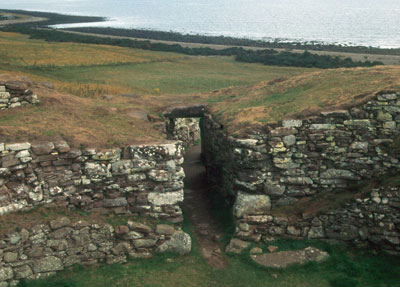
There was only one entrance, a passage about one metre wide that ran the whole thickness of the wall. In most cases this passage is oriented to face east—possibly because the prevailing winds blow out of the west but there may have been an element of religious symbolism as well. There are a significant number of brochs whose entrances face other directions—at Mousa and Midhowe they face due west, which would seem to rule out the ‘weather-related’ hypothesis in these instances. The interruption in the outer wall naturally put a lot of downward thrust on the lintels that made up the roof and these had to be selected and placed with care. Ceilings tended to be fairly low, forcing normal sized adults to stoop as they made their way along the passage. This would have put any attacker at a disadvantage, of course, but it is equally possible that the design had a more symbolic aim, forcing the individual to adopt a more humble posture when crossing the threshold.
To a certain extent, all dwellings were sacred places—safe refuges in a hostile cosmos—and this seems to have been the case in Atlantic Scotland. There are no other structures that could be interpreted as religious such as the stone circles and megalithic tombs of the Neolithic. Although 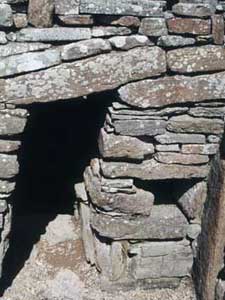 there are no such associations with brochs or roundhouses, the Iron Age wheelhouses that succeeded them have produced a number of deposits that are clearly ritual, at or near the entrance.
there are no such associations with brochs or roundhouses, the Iron Age wheelhouses that succeeded them have produced a number of deposits that are clearly ritual, at or near the entrance.
Where the evidence survives (in the form of ‘checks’ in the side walls), the door was placed part way down the passage, normally closer to the inner end. There were normally beam slots behind the checks so that the door could be barred from the inside. Socket stones have been found, indicating that some doors swung inwards, but they are rare and removable doors are equally possible.
Many roundhouses had one or two ‘guard cells’ placed near the inner end of the entrance passage (the one at Gurness Orkney is shown right). The entrances are quite small and it is hard to imagine what defensive function they served— unless they were kennels for an ancient breed of mastiff.
The Broch Interior
Sites where interior features survive and have been excavated are relatively few and are found mainly in the north, especially Orkney and Shetland. There is normally a central hearth and a number of partitions that divide the perimeter space into a number of rooms or compartments of various sizes. The layout survives reasonably well in Orkney because the builders used thin slabs of stone for the partitions. This arrangement is very similar to that found in contemporary timber frame houses and crannogs found in the lowlands as well as to the wheelhouses that replaced brochs in Atlantic Scotland. However, in some brochs, such as Dun Carloway, the ground floor is far too uneven to have been used as living space. In these circumstances a raised timber floor with the beam ends resting on the lower scarcement seems more likely. The hearth could have sat on a raised clay base.
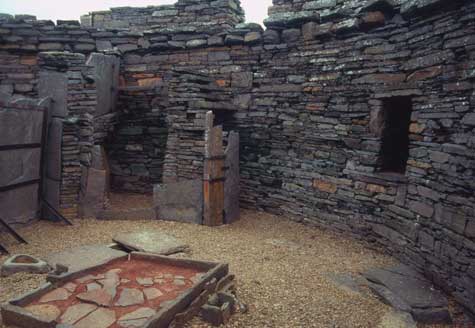
Interior of Midhowe Broch, Orkney
The space beneath the floor would have been ideal for stabling livestock—the practice of keeping animals on the ground floor of the farmhouse was quite common in pre-industrial Europe and can be found in many parts of the world today. Ancient breeds of cattle were much smaller than today’s and could have been accommodated comfortably. The body heat of the animals would have been very welcome, particularly in light of the scarcity of wood for fuel.
Galleries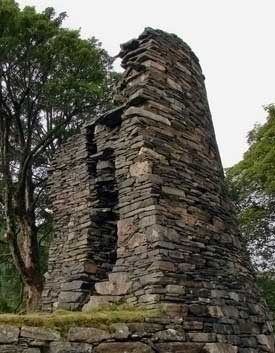
One common feature of the best-preserved brochs is the fact that the exterior wall is hollow for much of its height, creating what are known as galleries. They are the basis of the division of brochs into two basic types— Ground-Galleried (where the space runs the entire height of the wall) and Solid-Based (where it only begins at the level of the first storey). As stated in the Introduction, this distinction is largely (but not entirely geographic), with the solid-based types in Caithness, Sutherland and the Northern Isles and the ground-galleried types on the west coast and in the Hebrides.
Most scholars believe that galleries served two functions—to economize on building material and reduce the overall weight of the superstructure. In addition, the lower galleries are fairly spacious and carefully faced on the inside so that they could well have been used for storage or sleeping space. However, in most cases the galleries above the first floor are far too narrow to have been of much use and in some cases access to them has been blocked. The only exception is Mousa where there are no less than six superimposed galleries, all of them with ample room for adults to move 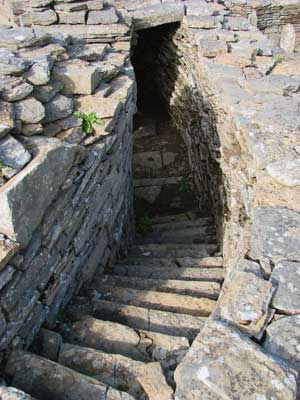 about. At several brochs there are tall vertical openings known as wall voids that run through the thickness of the inner wall and contain a number of superimposed shelves. At Dun Telve one such row is found above the entrance and might have been used to reduce the weight on the lintels but that cannot have been the prime function since most of the others, including one at Dun Telve itself, have no such association. In addition to galleries, some brochs were provided with one or more ground floor cells of varying size and shape. They were built into the thickness of the wall and generally had a corbelled ceiling high enough to allow a man to stand upright. There are intramural staircases at a number of the better preserved brochs connecting one level of galleries with the next and it was generally assumed that these were installed to allow access to a parapet at the top. However, this is only possible at Mousa, where the staircase winds all the way up. In most cases, entry to the staircase is from one of the ground floor cells but at a couple of the Orcadian examples, Gurness and Midhowe, the landing is well above floor level indicating that access was by means of a ladder or set of wooden steps. The treads of the steps show little sign of wear and Armit believes they were used mainly during the construction of the broch.
about. At several brochs there are tall vertical openings known as wall voids that run through the thickness of the inner wall and contain a number of superimposed shelves. At Dun Telve one such row is found above the entrance and might have been used to reduce the weight on the lintels but that cannot have been the prime function since most of the others, including one at Dun Telve itself, have no such association. In addition to galleries, some brochs were provided with one or more ground floor cells of varying size and shape. They were built into the thickness of the wall and generally had a corbelled ceiling high enough to allow a man to stand upright. There are intramural staircases at a number of the better preserved brochs connecting one level of galleries with the next and it was generally assumed that these were installed to allow access to a parapet at the top. However, this is only possible at Mousa, where the staircase winds all the way up. In most cases, entry to the staircase is from one of the ground floor cells but at a couple of the Orcadian examples, Gurness and Midhowe, the landing is well above floor level indicating that access was by means of a ladder or set of wooden steps. The treads of the steps show little sign of wear and Armit believes they were used mainly during the construction of the broch.
Scarcements
In virtually all the well-preserved brochs, narrow ledges are found running right around the circumference of the inner wall. In most cases, the wall above is recessed to create the ledge but sometimes the stones project from the wall face. They occur at a range of heights but something well above head height, maybe 2-2.5 metres, is the most common. Most likely they were designed to support the ends of beams for an upper floor. At Midhowe there is a clear relationship between the scarcement and the openings to first-floor galleries, which would seem to support this conclusion. In some cases both an upper and a lower scarcement have survived, suggesting two upper floors. At Dun Telve the upper scarcement is 9 metres above the floor and may have been part of the roof structure.
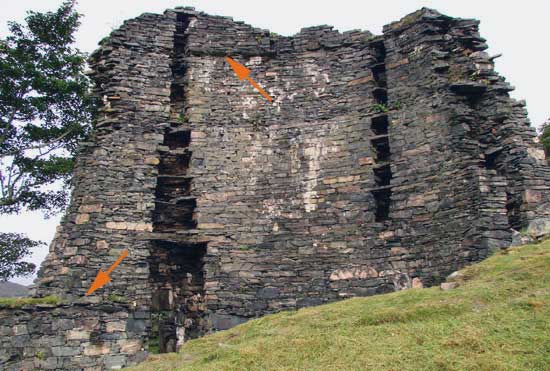
Interior of Dun Telve Broch, Lochalsh, showing the scarcements
Roofs
Given the climate, it is very doubtful if these structures were unroofed and there are a number of possibilities as to just how this was done. There is no evidence at all for a stone roof, no corbelling for example. In any case, the walls never could have supported the weight. In his excavations at Dun Trodden in 1920, Alexander Curle found a roughly circular arrangement of post holes that he interpreted as supports for the roof. He thought that the perimeter of the interior was covered using sloping timbers that rested on the scarcement but that the central area was left open. Most scholars consider the idea of water pouring into the middle of the broch an unlikely scenario, however.
The consensus today is that the tower was completely covered, probably by a conical thatched roof. A low roof supported by rafters resting on the low scarcement found in many brochs is extremely unlikely. Rain and snow would tend to collect at the base of the roof in the angle next to the wall. Moreover, in a number of cases, such a roof would have been far too low while in others it would have left features such as wall voids and the openings to galleries exposed to the elements. The most practical roof would have been at the top of the wall with the rafters resting on an upper scarcement or (more probably) on the top of the wall itself. The method suggested by Armit would see the roof resting on the top of the inner wall. If the outer wall was made slightly higher, it would protect the bottom edge and prevent the thatch from blown away by the strong winds that prevail in Atlantic Scotland.
Broch Design
One appealing suggestion is that brochs were designed with an eye to making the broch snug and dry in the relatively cold, wet and windy climate of Atlantic Scotland. Warm air from the hearth would be drawn through the wall voids and up through the galleries to heat the upper floors. The galleries would have also served as a barrier against the water that would have undoubtedly penetrated even the tightest fitting dry stone wall.
Broch Construction
It has been estimated that the broch at Dun Telve would have contained in excess of 2,000 tons of stone and would have taken something on the order of 6,000 man-days to erect. On top of that was the time and effort involved in quarrying and transporting the stone. Although there are plenty of examples of badly constructed brochs and roundhouses (the ever-collapsing building at Howe on Orkney is a case in point) there are a few, such as Mousa in Shetland, that are very well built. This has suggested to some scholars that there were a number of specialist broch architects.

